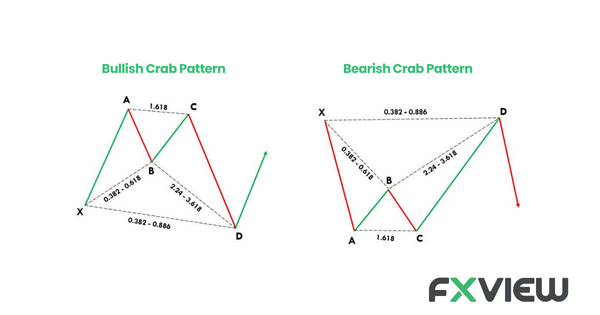
How to use the Crab Chart Pattern in Trading?
Ever wondered how the intricate dance of the ocean can inspire our trading techniques? Dive in as we explore the depths of the crab chart pattern, one of the harmonic patterns in the trading world. By the time we reach the shore, you’ll also gain insights into its close cousin, the Butterfly pattern in trading. So, fasten your life vests, and let’s set sail!
What is the Crab Chart Pattern?
The Crab pattern, with its quirky name, can be visualized as the undulating waves of the ocean; unpredictable yet rhythmic. This is not a creature of the deep sea we’re talking about, but an intriguing chart pattern that traders may keep an eye out for. Originating from the harmonic family, it’s a distant relative to the Butterfly pattern in trading, another favorite amongst chartists.
How to indicate the Crab Chart Pattern
Spotting a crab chart pattern amidst the vast ocean of trading charts is like finding a treasure chest buried in the sand. Here’s how to indicate it:
Start with the XA leg: Like the starting note of a captivating sea shanty, this is your foundation.
- The AB leg: This can be a retracement of up to 61.8% of the XA leg. It’s the first clue, much like spotting the tail of the crab.
- BC leg: A slight pullback, this can be anywhere between 38.2% to 88.6% of the AB leg. Think of it as the crab’s claw peeking out.
- The final CD leg: This is where the magic happens! It extends up to 161.8% – 224% of the XA leg, truly revealing the Crab in its full glory.

How can the Crab Chart Pattern be traded?
Trading the crab chart pattern is akin to sailing with the wind in your favor. It is important to understand the tides (the market), consider your compass (your analysis), and be ready to adjust your sails:
- Position Entry: Once the CD leg is forming, that may be your r cue. It’s like seeing a lighthouse in the distance, beaconing you.
- Stop Loss: It may be set just above (for bearish) or below (for bullish) the furthest point of the pattern. Better safe than sorry, especially when navigating the unpredictable seas of trading!
- Take Profit: Aim for a potential return towards the starting point of the CD leg. It’s like riding the wave back to the shore.
Bearish Crab Pattern vs. Bullish Crab Pattern
In the grand theatre of trading, the bearish crab chart pattern and the bullish crab chart pattern are two acts of the same play. While the bearish Crab pattern indicates a potential price drop, the bullish counterpart may suggest a possible uptrend.
- Bearish Crab pattern: This may emerge at the end of an uptrend. Imagine it as the tide pulling back, hinting at a potential storm brewing.
- Bullish Crab pattern: Found at the end of a downtrend, it’s the calm after the storm, indicating brighter days ahead.
How accurate is the Crab Chart Pattern?
In the vast sea of trading patterns, the Crab pattern is like the North Star. While no pattern offers 100% certainty (after all, the ocean has its mysteries), the Crab pattern, much like the Butterfly pattern trading technique, is respected among the trading community. However, as with all strategies, you may consider combining it with other tools for a better-constructed navigation and bear in mind that trading patterns should not be the sole source to rely on when making informed trading decisions Therefore, it could be essential to establish a well-constructed risk management approach.
Key Takeaways
- The Crab pattern, a jewel from the harmonic family, is akin to the Butterfly pattern in trading, offering traders a rhythmic guide in the tumultuous sea of trading.
- Indicating the Crab pattern can be important, much like decoding a pirate’s map.
- Trading the crab chart pattern requires patience, observation, and a well-structured risk management approach!
- The dance between the bearish and bullish Crab patterns showcases the ebb and flow of the market.
- You may consider using it in conjunction with other tools, in order to have a well-rounded approach.
Conclusion
While the Crab pattern, along with its close cousin, the Butterfly pattern, can be valuable guides, it’s important to remember that no trading strategy is foolproof. The sea of trading is filled with uncertainties and surprises, and patterns like the Crab are just one part of the puzzle. To enhance your trading journey, it’s wise to complement these patterns with other technical and fundamental analysis tools. So, next time you set sail in the trading waters, you may consider keeping an eye out for the Crab and its kin, the Butterfly pattern in trading. With these patterns by your side, may your trading journey be as exciting as a pirate’s adventure!
Disclaimer: The information contained in this article is provided for educational and informational purposes only and it is not intended to be, nor does it constitute financial, investment or trading advice. You should not make any financial, investment or trading decision based on the information provided in this article without performing your own research or seeking advice from an independent advisor.



